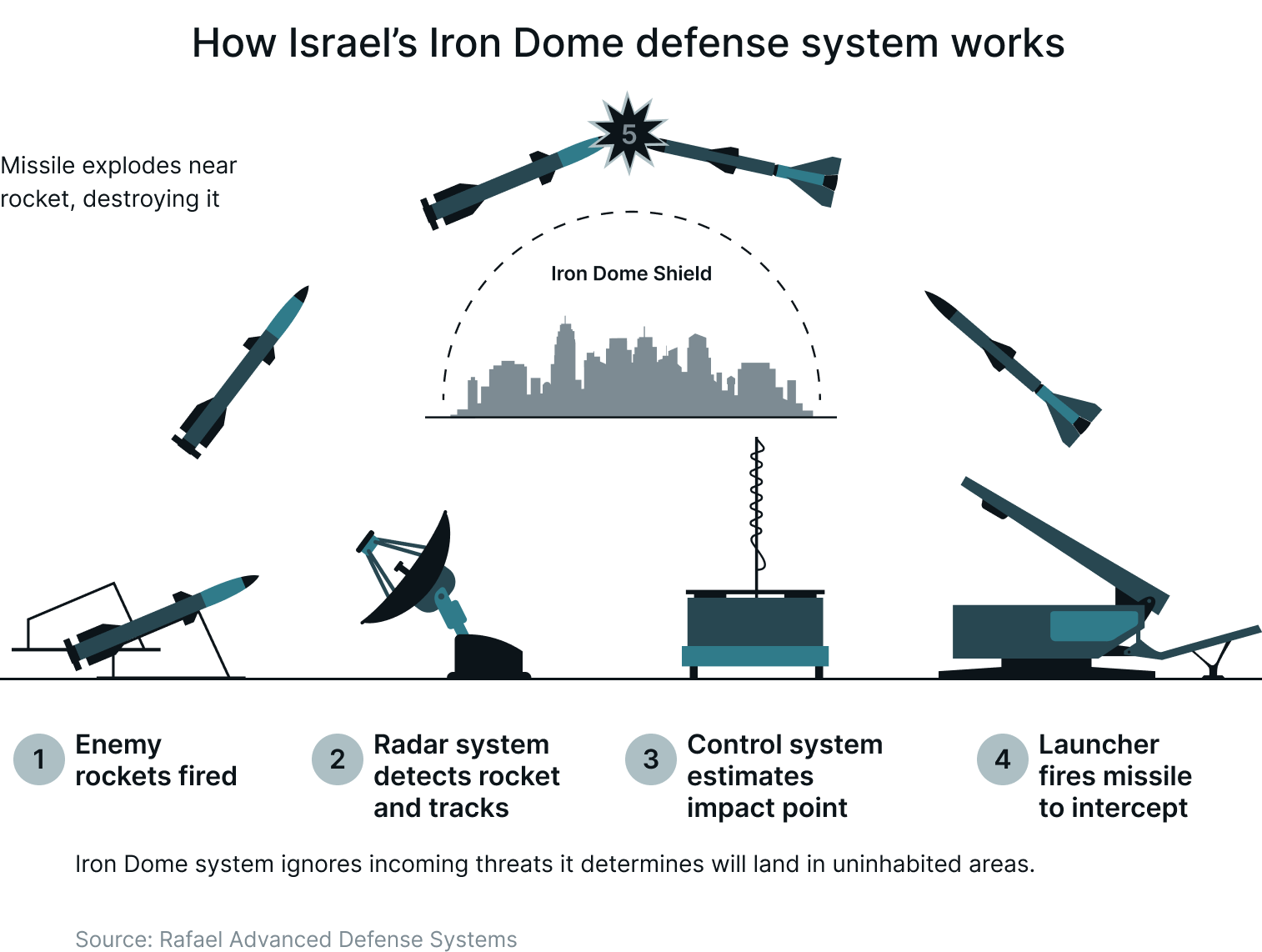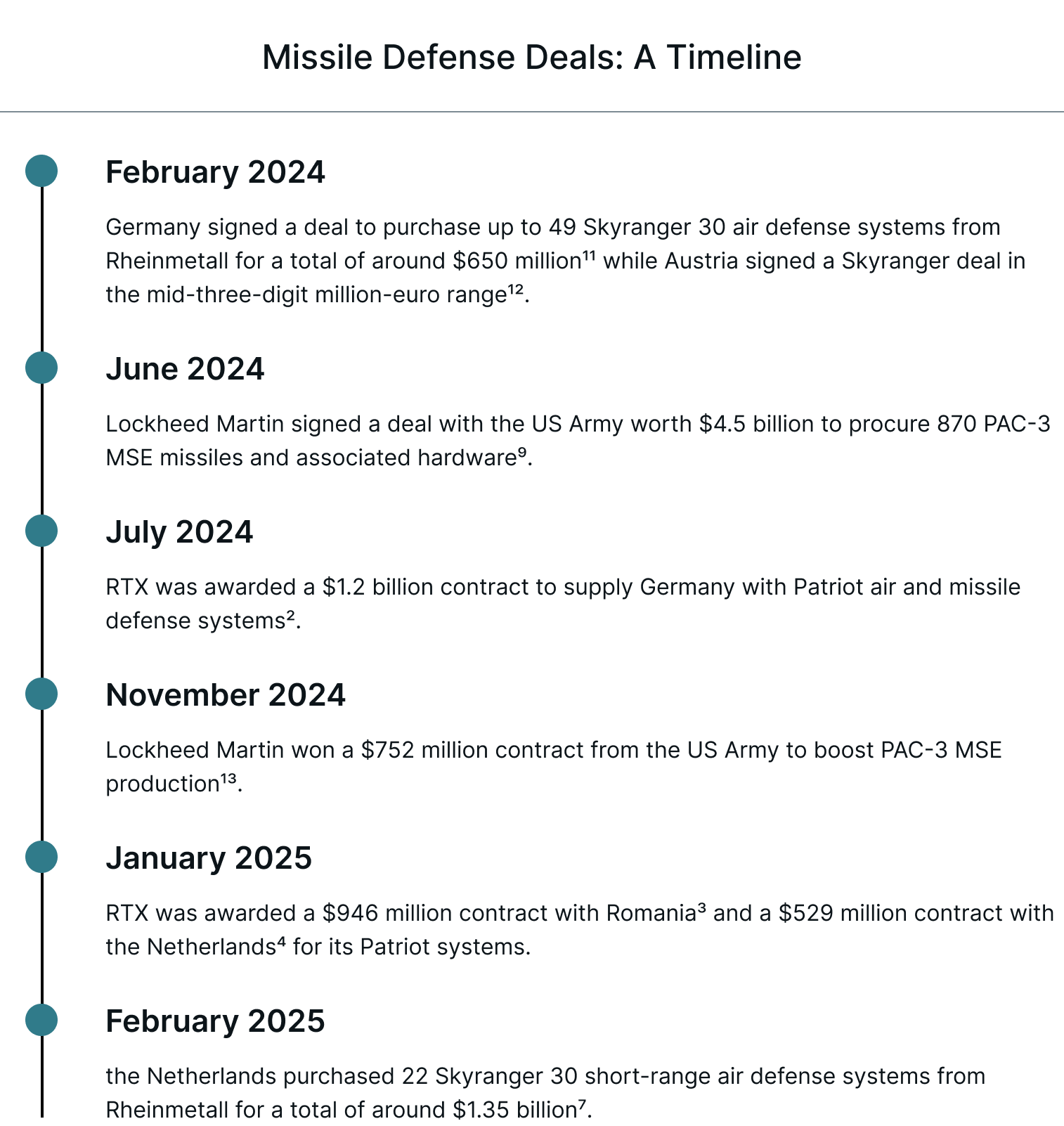July 14, 2025
Defense Stocks: 3 Companies Specializing In Missile and Drone Defense
The recent conflict between Israel and Iran has highlighted an area of defense that has become increasingly important in recent decades: missile and drone defense. In a world of advanced aerial weapon technology, it is crucial that countries have the ability to detect, track, and intercept incoming missiles and drones so that they can protect their citizens and critical infrastructure.
As nations globally aim to protect the skies above, defense companies that specialize in these systems could see orders and revenues grow. With that in mind, here’s a look at three companies that are involved in the production of state-of-the-art missile and drone defense systems today.
RTX Corp
RTX Corp, formerly known as Raytheon Technologies, is widely regarded as a global leader in missile defense. Via its Raytheon segment, it produces a vast range of related products including radar systems, interceptors, and command-and-control (C2) systems.
When it comes to aerial defense, RTX is best known for its Patriot system. One of the most widely deployed air and missile defense solutions globally, this is a system consisting of radars, command-and-control technology, and multiple types of interceptors – which all work together to detect, identify, and eliminate aerial threats. Capable of defending against tactical ballistic missiles, cruise missiles, drones, and advanced aircraft, the system is a cornerstone of aerial defense for the US and 18 other nations. Since it was first fielded in the early 1980s, it has been used in more than 250 combat engagements1.
Over the last 12 months, RTX has been awarded a number of big contracts for its Patriot system. In July 2024, it landed a $1.2 billion contract to supply Germany with these systems2. "This contract reflects the global emphasis on advanced air and missile defense capabilities and the steadfast confidence in Patriot," said Tom Laliberty, president of Land and Air Defense Systems at Raytheon at the time. More recently, in January 2025, RTX landed a $946 million deal with Romania3 and a $529 million contract with the Netherlands4.
Another advanced air defense product developed by RTX (in conjunction with Rafael Advanced Defense Systems) is the David’s Sling system. Designed to destroy longer-range rockets, cruise missiles, and medium-range or long-range ballistic missiles from a distance of up to 300 kilometers, this forms a crucial element of Israel’s multi-tier layered missile defense architecture today. Raytheon has also partnered with Rafael to develop the short-range Iron Dome Weapon System – another aerial defense system used by Israel. This has intercepted more than 1,500 incoming targets since being fielded in 20115, with a success rate exceeding 90 percent.
Alongside these integrated systems, RTX offers a range of strategic missile defense products including sensors (e.g. the SPY-6 range of radars) and interceptors (e.g. the SM-3 and the SM-6). So overall, it seeks to offer a full suite of air and missile defense solutions, covering threats from simple drones and rockets all the way up to strategic ballistic missiles and emerging hypersonic weapons.

Rheinmetall
German defense powerhouse Rheinmetall is another major player in the air and missile defense space, offering a comprehensive range of products and systems. Primarily focused on short-range air defense, it is well known for its cannon-based defense systems and integrated solutions that combine guns and missiles.
One line of Rheinmetall products that is in demand today is the Skyranger family (Skyranger 30, Skyranger 35) of mobile air defense systems. These are designed to protect against a wide range of modern battlefield threats including drones, fixed-wing aircraft, helicopters, and cruise missiles. In recent years, a number of European countries, including Germany, Austria, the Netherlands, Hungary, and Denmark, have signed deals to purchase Skyranger systems6 while several other countries, including the Czech Republic and Lithuania, have shown interest in them. The deal with the Netherlands is worth highlighting here – it purchased 22 Skyranger 30 short-range air defense systems for a total of around $1.35 billion in February 20257.
Rheinmetall has also been having success with its latest networked air defense system, Skynex. This system, which to date has been acquired by a range of countries including Ukraine, Austria, and Qatar, boasts an open and modular architecture – allowing various sensors and effectors to be integrated – and which help to create gun-based effectors with the ability to integrate surface-to-air missiles and high-energy lasers to create a layered defense system. Earlier this year, the Italian Army placed an order with Rheinmetall for a first Skynex air defense system as part of a wider contract that includes an option to acquire an additional three platforms. Rheinmetall noted that this Skynex deal – the first from a NATO country – could be worth up to €280 million8.
Lockheed Martin Corp
As the world's largest defense contractor, Lockheed Martin naturally has a significant footprint in missile defense. Emphasizing a "21st Century Security" approach, it aims to integrate different solutions to help countries create a seamless, layered defense capable of protecting against a wide range of threats, including ballistic missiles, cruise missiles, and emerging hypersonic threats.
Lockheed Martin is the prime contractor for the Terminal High Altitude Area Defense (THAAD) system. This is a highly effective missile defense system designed to intercept and destroy short, medium, and intermediate-range ballistic missiles. A crucial component of the United States' ballistic missile defense strategy, it currently defends population centers and high value infrastructures across the US. Today, it is the only US system designed to intercept missiles inside or outside the atmosphere.
Lockheed is also the manufacturer of the PAC-3 Missile Segment Enhancement (MSE). This is the most advanced interceptor missile within RTX’s Patriot air and missile defense system. In recent years, the US Army has awarded the company a number of major contracts for these interceptors. In June 2024, it signed a deal worth $4.5 billion to procure 870 PAC-3 MSE missiles and associated hardware9.
It’s worth noting that in April 2024, Lockheed Martin announced that it was selected by the US Missile Defense Agency (MDA) to develop the Next Generation Interceptor (NGI)10. The goal here is to develop, produce, and deliver a modern, never-fail weapon capable of protecting against long-range ballistic missile threats from rogue nations. The company states on its website that its NGI solution has begun a transition from the technology development phase to the product development phase. It believes that its solution is both efficient and capable of staying ahead of current and future threats.
In the C2 space, Lockheed Martin leads the development of the C2BMC (Command, Control, Battle Management, and Communications) program. This is a critical operations system that helps to enable the US to systematically plan and manage ballistic missile defense operations and seeks to allow for synchronized decision-making across the world. Other C2 systems developed by the company include the Aegis Combat System, which is a sophisticated C2 system for naval vessels, and the DIAMONDShield, an advanced air and missile C2 system that leverages expertise gained from systems like C2BMC. So overall, it is a major player when it comes to advanced C2 systems that can integrate vast amounts of data, provide real-time battlespace awareness, and empower rapid, informed decision-making for complex military operations across multiple domains.
A Vital Area of Defense
The recent conflict in the Middle East has served as a stark reminder of the importance of robust missile and drone defense capabilities today. These technologies are not merely offensive deterrents; they are vital shields, safeguarding civilian populations, critical infrastructure, and national security. In an era where aerial threats are becoming increasingly sophisticated, continued investment in these technologies is likely. This should serve companies like RTX, Rheinmetall, and Lockheed Martin well, as they are at the forefront of this essential area of defense, developing advanced systems that can detect, track, and intercept a myriad of aerial threats.

Footnotes:
*Specific investments described herein do not represent all investment decisions made by Themes Management Company LLC. The reader should not assume that investment decisions identified and discussed were or will be profitable. Specific investment advice references provided herein are for illustrative purposes only and are not necessarily representative of investments that will be made in the future.
1Raytheon, Global Patriot Solutions, as of June 26, 2025
2Raytheon, RTX's Raytheon awarded $1.2 billion contract to provide Patriot air and missile defense systems to Germany, as of March 21, 2024
3Raytheon, RTX's Raytheon awarded $946 million contract to provide additional Patriot air defense systems to Romania, as of January 3, 2025
4Raytheon, RTX's Raytheon awarded $529 million contract to replenish Dutch Patriot air defense system, as of January 16, 2025
5Raytheon, Iron Dome System and SkyHunter Missile, as of June 26, 2025
6Army Recognition, Rheinmetall to begin Skyranger 30 deliveries to strengthen European air defense capabilities, as of December 3, 2024
7CUAS Hub, Netherlands to acquire 22 Skyranger systems in $1.35 billion deal, as of February 10, 2025
8Breaking Defense, Italy sets up $289 million Skynex air defense deal with Rheinmetall, as of January 15, 2025
9U.S Army, Army awards $4.5 billion Patriot Advanced Capability-3 Missile Segment Enhancement missile multiyear contract, as of June 28, 2024
10Lockheed Martin, U.S. Missile Defense Agency selects Lockheed Martin to provide its Next Generation Interceptor, as of April 15, 2024
11Defense News, Germany buys Rheinmetall’s Skyranger to reinstate mobile air defenses, as of February 28, 2024
12Rheinmetall, Market breakthrough in Austria: Rheinmetall supplying Skyranger air defence system on Pandur wheeled armoured vehicle, as of February 23, 2024
13Army Technology, Lockheed Martin wins $752.3m contract to boost PAC-3 MSE production, as of November 29, 2024



